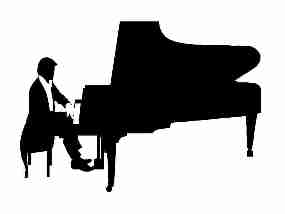|
STEPS PERFORMED ON OUR RECONDITIONED PIANOS
All photos are clickable for a larger
image Back
to Page 1: Basic Disassembly and
Cleaning
Back to
page 2: Action Repairs and Regulation
(Adjustment)
Page 3: Cabinet and Brass Work Almost
every piano cabinet we see needs some degree of touchup, and ALL need the
hardware polished. I have yet to see one piano where the owner has
kept the brass polished. Some of the cabinet repairs as as simple as
using a little scratch cover and polish, others require filling or
replacing damaged wood. Replacement of the little rubber head nails
that protect cabinet parts from resting on one another is another small
detail that is often overlooked. Most
of the hardware found on pianos manufactured since WWII is brass.
Some cheaper pianos will have brass plated steel items but most of the
hinges, pedals, etc. will be solid brass. One exception is the
casters, which in most cases have a brass plated steel frame supporting
the wheel, and usually cannot be buffed and must instead be
replaced. This piano, being a studio, has the double rubber wheel
casters that are not well seen and thus not as decorative.
  |
|
Common area to see damaged - the front of the
toe block - seen on pianos often intended for use in churches and
schools, though not rare in homes. This "extra"
block of wood helps support the lower part of the leg and reduces
breakage from moving. Left photo before touchup, right
after. Not perfect, but significantly better. |
|
  |
 |
Here is another good example of damage commonly
found on pianos. Bear in mind that this piano came from a
private home, and was not subjected to the abuse that is often
seen in school pianos. This damage most likely came from
being moved by someone other than a professional crew and was done
probably when struck against a step or threshold. The top
left photo shows a poor attempt (not us) to cover the damage with
a popular scratch cover. The top right photo shows the area
filled and sanded and the photo to the left shows the area after
proper color and grain and clearcoat has been applied. |
|
  |
 |
This series of photos shows the brass lock going
through the stages of being polished. The top left is before
anything was done. The top right shows the lock after
polishing - but wait, we're not done yet! The photo to the
left shows the finishing touch - a coat of lacquer to help retain
the shine for years to come. Without this the lock would
tarnish again in a very short time. |
|
 |
This photo shows the difference between a pedal that
has not been buffed (left) and one that has (right). Doesn't
seem like a big difference, but a lot of little things combine to
make our used pianos stand out among the competition. |
|
|


|
|
Tightening case parts, including the piano leg
(left), bench legs (right) and other parts not pictured such as
the music rack, top, key cover (also called the fallboard) are
also very important and part of the reconditioning process we
perform. |
|
For now, this concludes the
tutorial. I will be expanding it over time, but this shows
you the steps we go through and the attention we pay to detail
when reconditioning our used pianos. As we've said before,
compare us to anyone online and I think you will find few stores
who match our service. We won't be the cheapest, but we will
be among the best.
|
|
|












